Understanding Long-Term Conditions: Cognitive Therapy for Spondylosis
VerifiedAdded on 2023/06/18
|14
|4931
|264
Report
AI Summary
This report explores the use of cognitive behavioral therapy (CBT) for managing chronic pain and stress associated with Lumbar Spondylosis, an age-related condition affecting the bones and discs of the spine. It highlights the problems faced by individuals with this condition, including physical pain, mental stress, and potential neurological complications. The report discusses the current gaps in pain management, focusing on the limitations and advantages of CBT compared to other therapies like acupuncture and physical therapy. It emphasizes the importance of patient cooperation, the role of health psychologists, and the emotional challenges patients may face during CBT. The intervention and its working discusses psychological treatments, mindfulness-based interventions, body awareness, and mindfulness-based cognitive therapy (MBCT) as strategies to alleviate pain and improve overall well-being. The report also touches upon the quality of evidence supporting CBT and the use of resources in its implementation, ultimately advocating for a multidisciplinary approach and increased investment in psychology-based treatments for long-term conditions.

UNDERSTANDING LONG
TERM CONDITIONS
TERM CONDITIONS
Paraphrase This Document
Need a fresh take? Get an instant paraphrase of this document with our AI Paraphraser
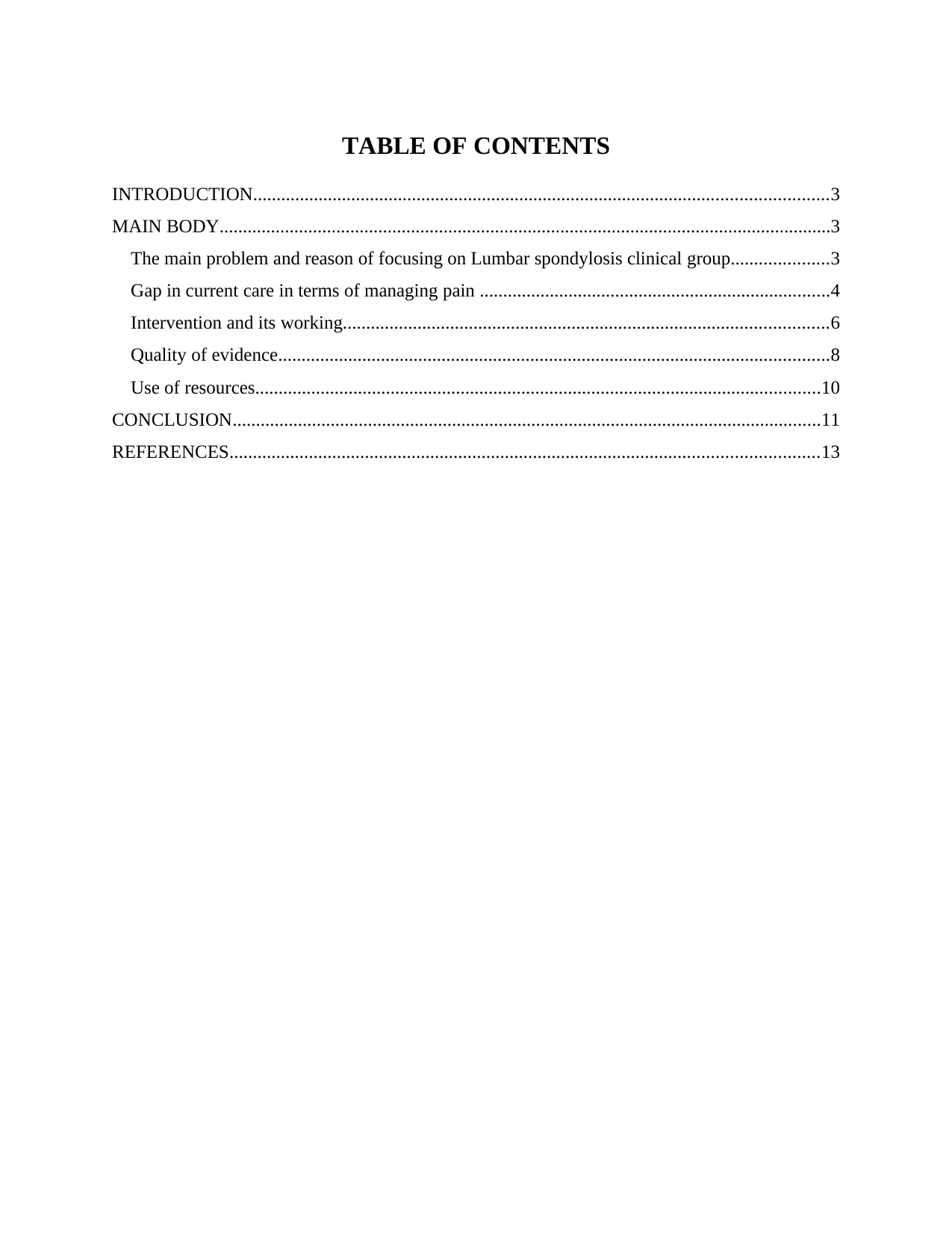
TABLE OF CONTENTS
INTRODUCTION...........................................................................................................................3
MAIN BODY...................................................................................................................................3
The main problem and reason of focusing on Lumbar spondylosis clinical group.....................3
Gap in current care in terms of managing pain ...........................................................................4
Intervention and its working........................................................................................................6
Quality of evidence......................................................................................................................8
Use of resources.........................................................................................................................10
CONCLUSION..............................................................................................................................11
REFERENCES..............................................................................................................................13
INTRODUCTION...........................................................................................................................3
MAIN BODY...................................................................................................................................3
The main problem and reason of focusing on Lumbar spondylosis clinical group.....................3
Gap in current care in terms of managing pain ...........................................................................4
Intervention and its working........................................................................................................6
Quality of evidence......................................................................................................................8
Use of resources.........................................................................................................................10
CONCLUSION..............................................................................................................................11
REFERENCES..............................................................................................................................13
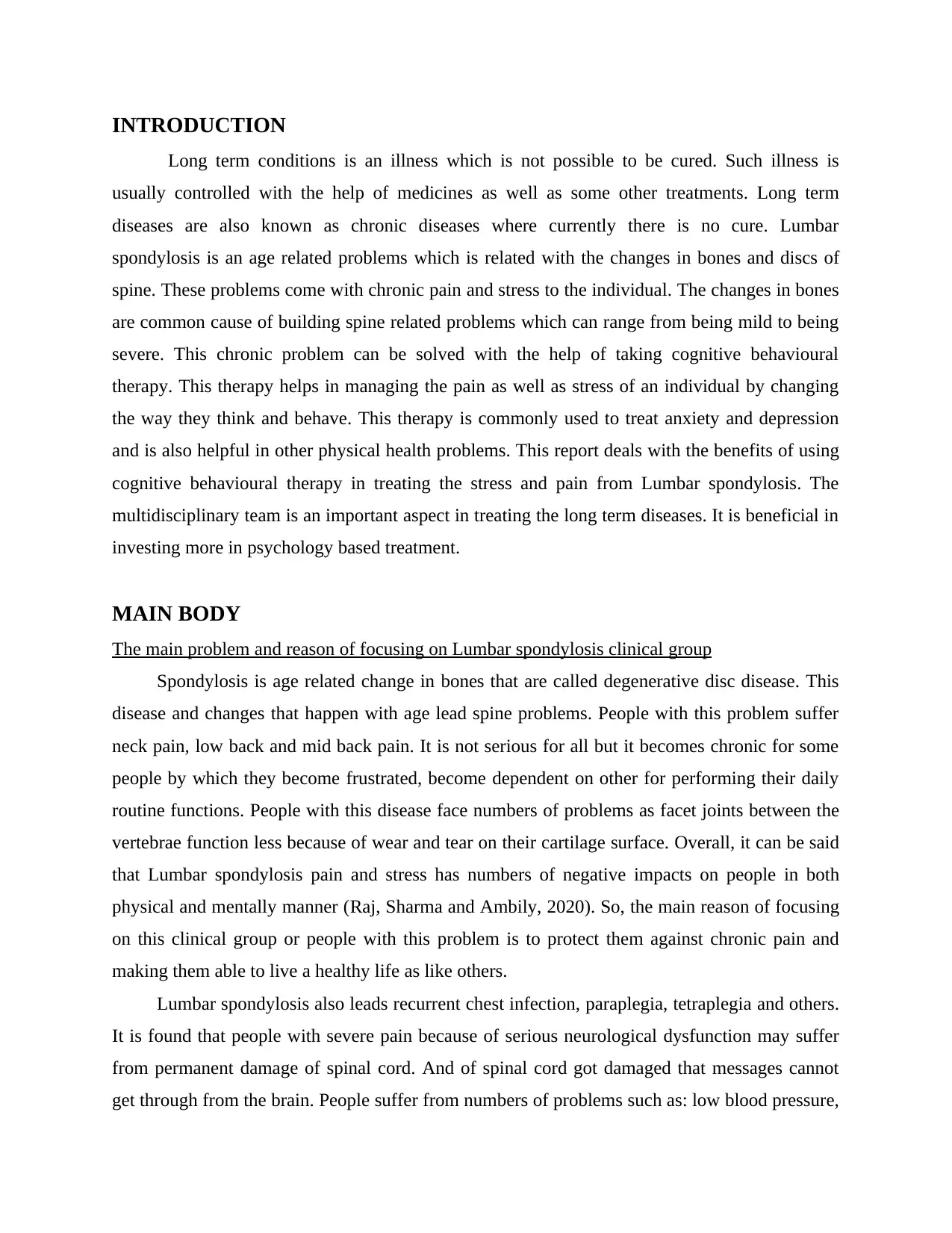
INTRODUCTION
Long term conditions is an illness which is not possible to be cured. Such illness is
usually controlled with the help of medicines as well as some other treatments. Long term
diseases are also known as chronic diseases where currently there is no cure. Lumbar
spondylosis is an age related problems which is related with the changes in bones and discs of
spine. These problems come with chronic pain and stress to the individual. The changes in bones
are common cause of building spine related problems which can range from being mild to being
severe. This chronic problem can be solved with the help of taking cognitive behavioural
therapy. This therapy helps in managing the pain as well as stress of an individual by changing
the way they think and behave. This therapy is commonly used to treat anxiety and depression
and is also helpful in other physical health problems. This report deals with the benefits of using
cognitive behavioural therapy in treating the stress and pain from Lumbar spondylosis. The
multidisciplinary team is an important aspect in treating the long term diseases. It is beneficial in
investing more in psychology based treatment.
MAIN BODY
The main problem and reason of focusing on Lumbar spondylosis clinical group
Spondylosis is age related change in bones that are called degenerative disc disease. This
disease and changes that happen with age lead spine problems. People with this problem suffer
neck pain, low back and mid back pain. It is not serious for all but it becomes chronic for some
people by which they become frustrated, become dependent on other for performing their daily
routine functions. People with this disease face numbers of problems as facet joints between the
vertebrae function less because of wear and tear on their cartilage surface. Overall, it can be said
that Lumbar spondylosis pain and stress has numbers of negative impacts on people in both
physical and mentally manner (Raj, Sharma and Ambily, 2020). So, the main reason of focusing
on this clinical group or people with this problem is to protect them against chronic pain and
making them able to live a healthy life as like others.
Lumbar spondylosis also leads recurrent chest infection, paraplegia, tetraplegia and others.
It is found that people with severe pain because of serious neurological dysfunction may suffer
from permanent damage of spinal cord. And of spinal cord got damaged that messages cannot
get through from the brain. People suffer from numbers of problems such as: low blood pressure,
Long term conditions is an illness which is not possible to be cured. Such illness is
usually controlled with the help of medicines as well as some other treatments. Long term
diseases are also known as chronic diseases where currently there is no cure. Lumbar
spondylosis is an age related problems which is related with the changes in bones and discs of
spine. These problems come with chronic pain and stress to the individual. The changes in bones
are common cause of building spine related problems which can range from being mild to being
severe. This chronic problem can be solved with the help of taking cognitive behavioural
therapy. This therapy helps in managing the pain as well as stress of an individual by changing
the way they think and behave. This therapy is commonly used to treat anxiety and depression
and is also helpful in other physical health problems. This report deals with the benefits of using
cognitive behavioural therapy in treating the stress and pain from Lumbar spondylosis. The
multidisciplinary team is an important aspect in treating the long term diseases. It is beneficial in
investing more in psychology based treatment.
MAIN BODY
The main problem and reason of focusing on Lumbar spondylosis clinical group
Spondylosis is age related change in bones that are called degenerative disc disease. This
disease and changes that happen with age lead spine problems. People with this problem suffer
neck pain, low back and mid back pain. It is not serious for all but it becomes chronic for some
people by which they become frustrated, become dependent on other for performing their daily
routine functions. People with this disease face numbers of problems as facet joints between the
vertebrae function less because of wear and tear on their cartilage surface. Overall, it can be said
that Lumbar spondylosis pain and stress has numbers of negative impacts on people in both
physical and mentally manner (Raj, Sharma and Ambily, 2020). So, the main reason of focusing
on this clinical group or people with this problem is to protect them against chronic pain and
making them able to live a healthy life as like others.
Lumbar spondylosis also leads recurrent chest infection, paraplegia, tetraplegia and others.
It is found that people with severe pain because of serious neurological dysfunction may suffer
from permanent damage of spinal cord. And of spinal cord got damaged that messages cannot
get through from the brain. People suffer from numbers of problems such as: low blood pressure,
⊘ This is a preview!⊘
Do you want full access?
Subscribe today to unlock all pages.

Trusted by 1+ million students worldwide
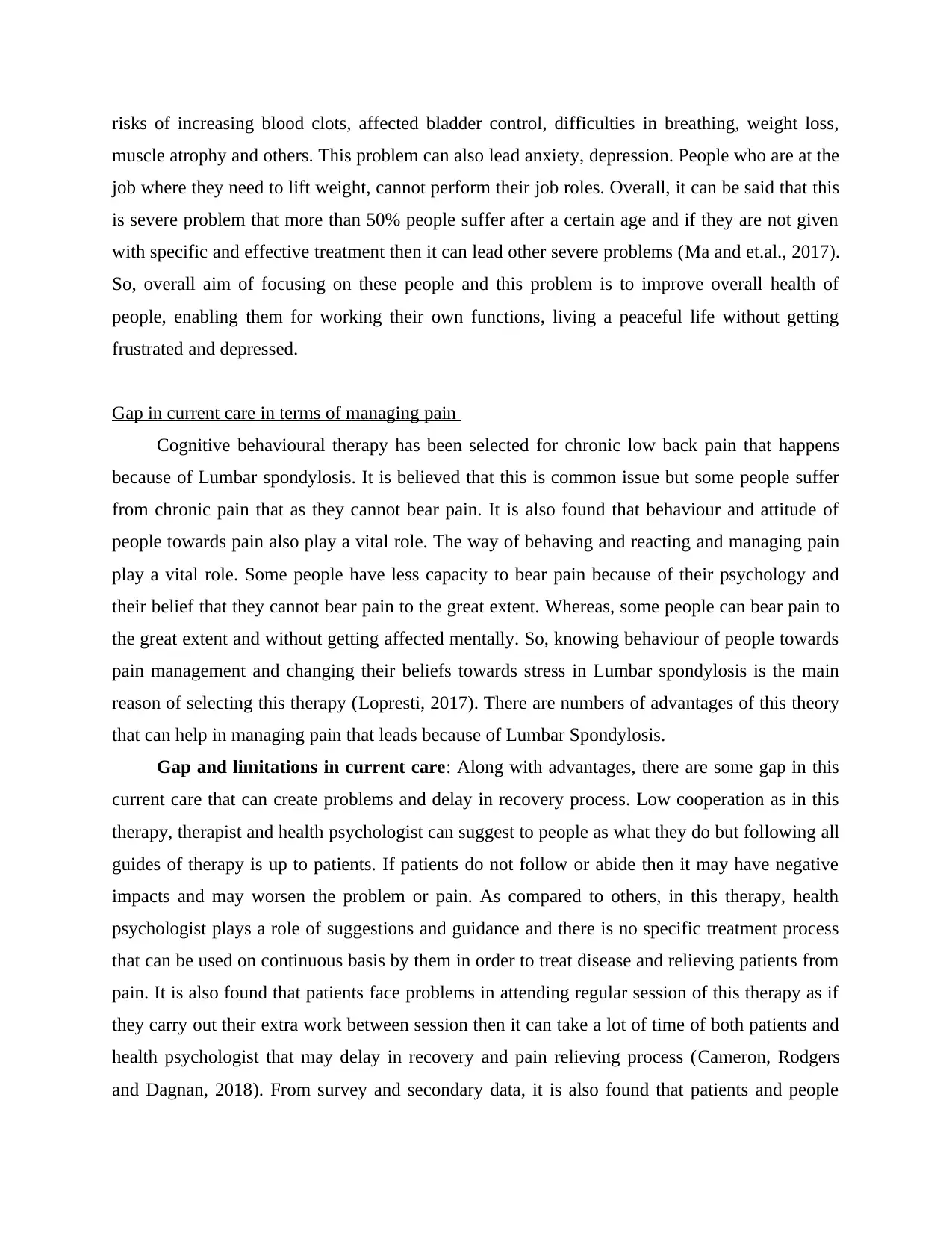
risks of increasing blood clots, affected bladder control, difficulties in breathing, weight loss,
muscle atrophy and others. This problem can also lead anxiety, depression. People who are at the
job where they need to lift weight, cannot perform their job roles. Overall, it can be said that this
is severe problem that more than 50% people suffer after a certain age and if they are not given
with specific and effective treatment then it can lead other severe problems (Ma and et.al., 2017).
So, overall aim of focusing on these people and this problem is to improve overall health of
people, enabling them for working their own functions, living a peaceful life without getting
frustrated and depressed.
Gap in current care in terms of managing pain
Cognitive behavioural therapy has been selected for chronic low back pain that happens
because of Lumbar spondylosis. It is believed that this is common issue but some people suffer
from chronic pain that as they cannot bear pain. It is also found that behaviour and attitude of
people towards pain also play a vital role. The way of behaving and reacting and managing pain
play a vital role. Some people have less capacity to bear pain because of their psychology and
their belief that they cannot bear pain to the great extent. Whereas, some people can bear pain to
the great extent and without getting affected mentally. So, knowing behaviour of people towards
pain management and changing their beliefs towards stress in Lumbar spondylosis is the main
reason of selecting this therapy (Lopresti, 2017). There are numbers of advantages of this theory
that can help in managing pain that leads because of Lumbar Spondylosis.
Gap and limitations in current care: Along with advantages, there are some gap in this
current care that can create problems and delay in recovery process. Low cooperation as in this
therapy, therapist and health psychologist can suggest to people as what they do but following all
guides of therapy is up to patients. If patients do not follow or abide then it may have negative
impacts and may worsen the problem or pain. As compared to others, in this therapy, health
psychologist plays a role of suggestions and guidance and there is no specific treatment process
that can be used on continuous basis by them in order to treat disease and relieving patients from
pain. It is also found that patients face problems in attending regular session of this therapy as if
they carry out their extra work between session then it can take a lot of time of both patients and
health psychologist that may delay in recovery and pain relieving process (Cameron, Rodgers
and Dagnan, 2018). From survey and secondary data, it is also found that patients and people
muscle atrophy and others. This problem can also lead anxiety, depression. People who are at the
job where they need to lift weight, cannot perform their job roles. Overall, it can be said that this
is severe problem that more than 50% people suffer after a certain age and if they are not given
with specific and effective treatment then it can lead other severe problems (Ma and et.al., 2017).
So, overall aim of focusing on these people and this problem is to improve overall health of
people, enabling them for working their own functions, living a peaceful life without getting
frustrated and depressed.
Gap in current care in terms of managing pain
Cognitive behavioural therapy has been selected for chronic low back pain that happens
because of Lumbar spondylosis. It is believed that this is common issue but some people suffer
from chronic pain that as they cannot bear pain. It is also found that behaviour and attitude of
people towards pain also play a vital role. The way of behaving and reacting and managing pain
play a vital role. Some people have less capacity to bear pain because of their psychology and
their belief that they cannot bear pain to the great extent. Whereas, some people can bear pain to
the great extent and without getting affected mentally. So, knowing behaviour of people towards
pain management and changing their beliefs towards stress in Lumbar spondylosis is the main
reason of selecting this therapy (Lopresti, 2017). There are numbers of advantages of this theory
that can help in managing pain that leads because of Lumbar Spondylosis.
Gap and limitations in current care: Along with advantages, there are some gap in this
current care that can create problems and delay in recovery process. Low cooperation as in this
therapy, therapist and health psychologist can suggest to people as what they do but following all
guides of therapy is up to patients. If patients do not follow or abide then it may have negative
impacts and may worsen the problem or pain. As compared to others, in this therapy, health
psychologist plays a role of suggestions and guidance and there is no specific treatment process
that can be used on continuous basis by them in order to treat disease and relieving patients from
pain. It is also found that patients face problems in attending regular session of this therapy as if
they carry out their extra work between session then it can take a lot of time of both patients and
health psychologist that may delay in recovery and pain relieving process (Cameron, Rodgers
and Dagnan, 2018). From survey and secondary data, it is also found that patients and people
Paraphrase This Document
Need a fresh take? Get an instant paraphrase of this document with our AI Paraphraser
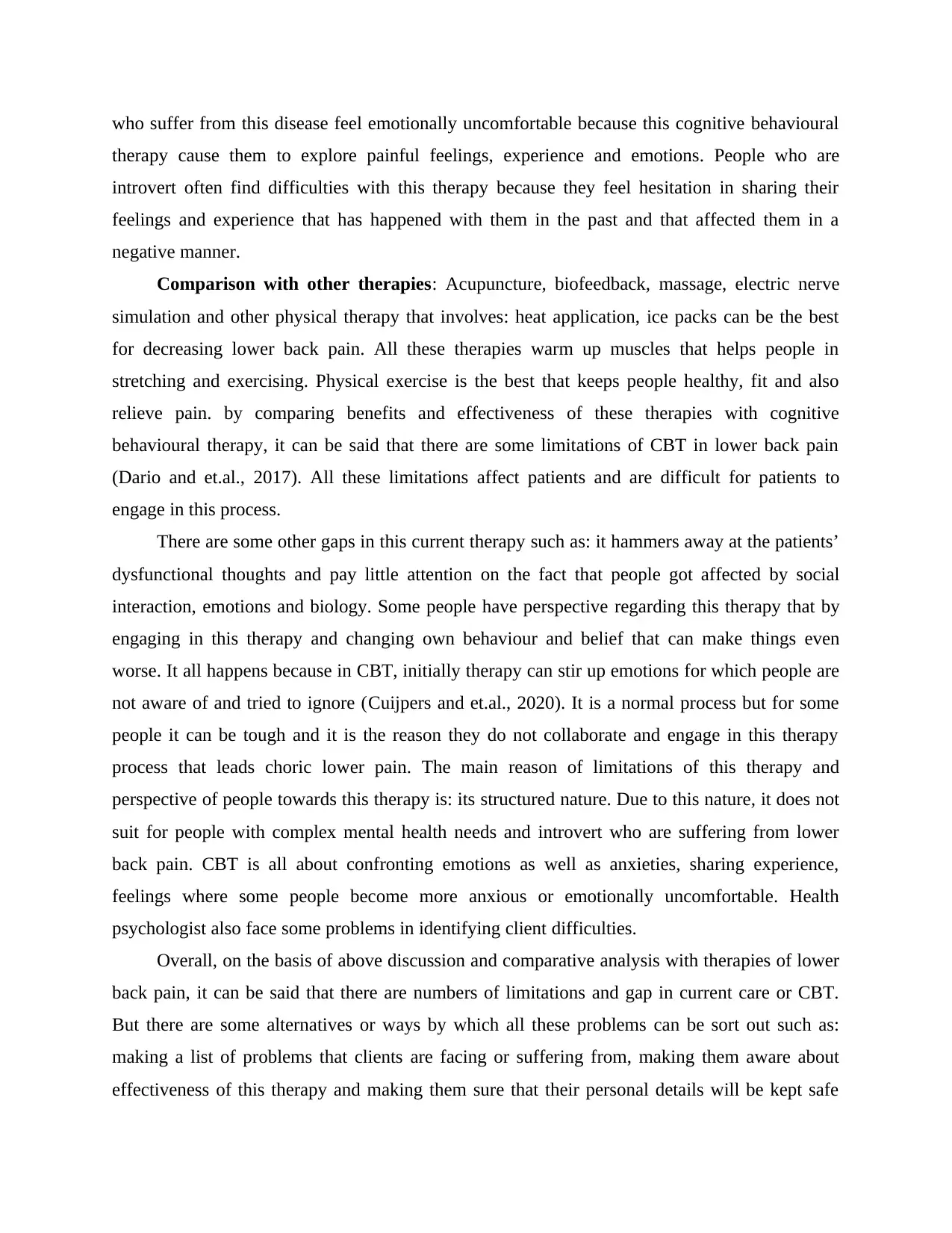
who suffer from this disease feel emotionally uncomfortable because this cognitive behavioural
therapy cause them to explore painful feelings, experience and emotions. People who are
introvert often find difficulties with this therapy because they feel hesitation in sharing their
feelings and experience that has happened with them in the past and that affected them in a
negative manner.
Comparison with other therapies: Acupuncture, biofeedback, massage, electric nerve
simulation and other physical therapy that involves: heat application, ice packs can be the best
for decreasing lower back pain. All these therapies warm up muscles that helps people in
stretching and exercising. Physical exercise is the best that keeps people healthy, fit and also
relieve pain. by comparing benefits and effectiveness of these therapies with cognitive
behavioural therapy, it can be said that there are some limitations of CBT in lower back pain
(Dario and et.al., 2017). All these limitations affect patients and are difficult for patients to
engage in this process.
There are some other gaps in this current therapy such as: it hammers away at the patients’
dysfunctional thoughts and pay little attention on the fact that people got affected by social
interaction, emotions and biology. Some people have perspective regarding this therapy that by
engaging in this therapy and changing own behaviour and belief that can make things even
worse. It all happens because in CBT, initially therapy can stir up emotions for which people are
not aware of and tried to ignore (Cuijpers and et.al., 2020). It is a normal process but for some
people it can be tough and it is the reason they do not collaborate and engage in this therapy
process that leads choric lower pain. The main reason of limitations of this therapy and
perspective of people towards this therapy is: its structured nature. Due to this nature, it does not
suit for people with complex mental health needs and introvert who are suffering from lower
back pain. CBT is all about confronting emotions as well as anxieties, sharing experience,
feelings where some people become more anxious or emotionally uncomfortable. Health
psychologist also face some problems in identifying client difficulties.
Overall, on the basis of above discussion and comparative analysis with therapies of lower
back pain, it can be said that there are numbers of limitations and gap in current care or CBT.
But there are some alternatives or ways by which all these problems can be sort out such as:
making a list of problems that clients are facing or suffering from, making them aware about
effectiveness of this therapy and making them sure that their personal details will be kept safe
therapy cause them to explore painful feelings, experience and emotions. People who are
introvert often find difficulties with this therapy because they feel hesitation in sharing their
feelings and experience that has happened with them in the past and that affected them in a
negative manner.
Comparison with other therapies: Acupuncture, biofeedback, massage, electric nerve
simulation and other physical therapy that involves: heat application, ice packs can be the best
for decreasing lower back pain. All these therapies warm up muscles that helps people in
stretching and exercising. Physical exercise is the best that keeps people healthy, fit and also
relieve pain. by comparing benefits and effectiveness of these therapies with cognitive
behavioural therapy, it can be said that there are some limitations of CBT in lower back pain
(Dario and et.al., 2017). All these limitations affect patients and are difficult for patients to
engage in this process.
There are some other gaps in this current therapy such as: it hammers away at the patients’
dysfunctional thoughts and pay little attention on the fact that people got affected by social
interaction, emotions and biology. Some people have perspective regarding this therapy that by
engaging in this therapy and changing own behaviour and belief that can make things even
worse. It all happens because in CBT, initially therapy can stir up emotions for which people are
not aware of and tried to ignore (Cuijpers and et.al., 2020). It is a normal process but for some
people it can be tough and it is the reason they do not collaborate and engage in this therapy
process that leads choric lower pain. The main reason of limitations of this therapy and
perspective of people towards this therapy is: its structured nature. Due to this nature, it does not
suit for people with complex mental health needs and introvert who are suffering from lower
back pain. CBT is all about confronting emotions as well as anxieties, sharing experience,
feelings where some people become more anxious or emotionally uncomfortable. Health
psychologist also face some problems in identifying client difficulties.
Overall, on the basis of above discussion and comparative analysis with therapies of lower
back pain, it can be said that there are numbers of limitations and gap in current care or CBT.
But there are some alternatives or ways by which all these problems can be sort out such as:
making a list of problems that clients are facing or suffering from, making them aware about
effectiveness of this therapy and making them sure that their personal details will be kept safe
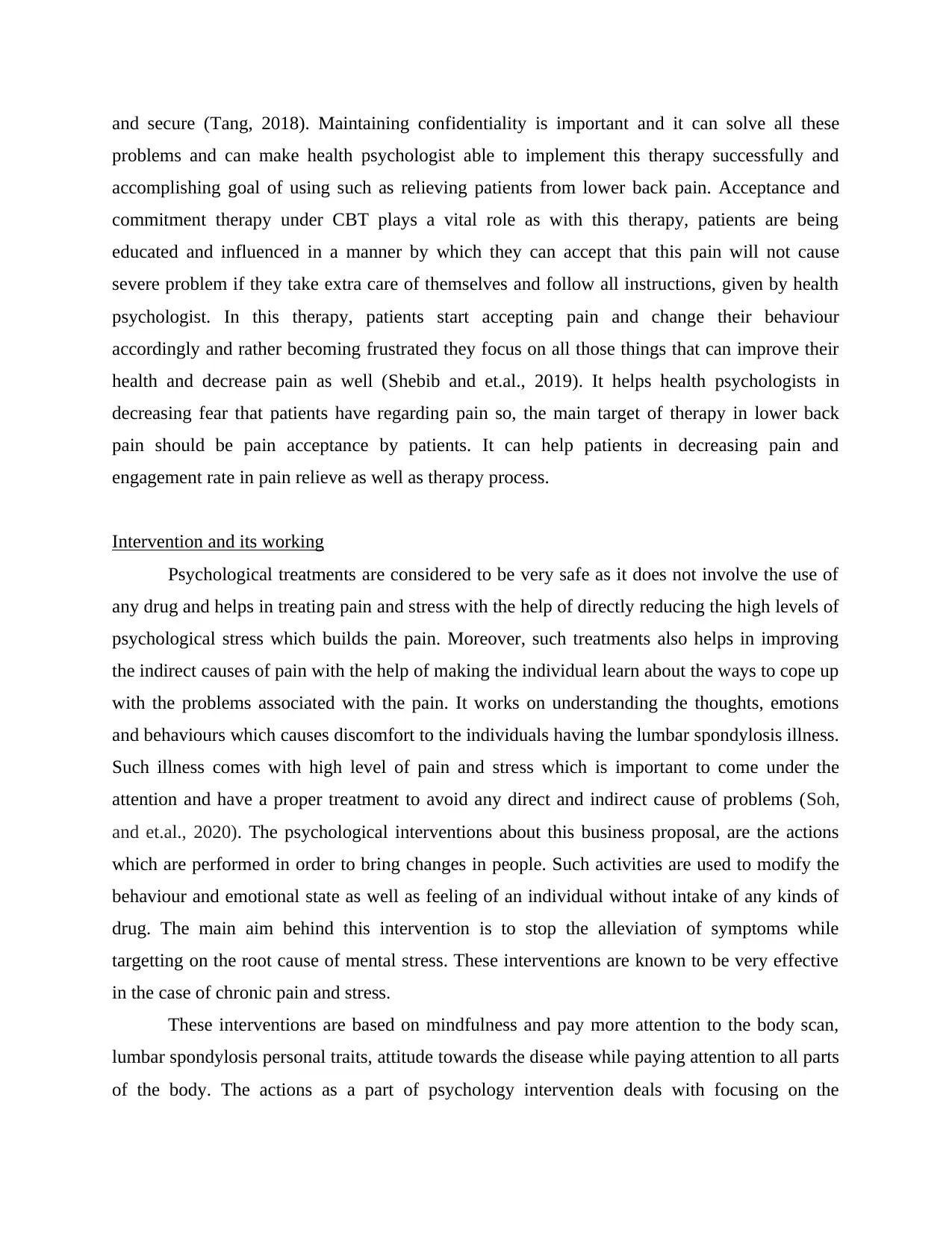
and secure (Tang, 2018). Maintaining confidentiality is important and it can solve all these
problems and can make health psychologist able to implement this therapy successfully and
accomplishing goal of using such as relieving patients from lower back pain. Acceptance and
commitment therapy under CBT plays a vital role as with this therapy, patients are being
educated and influenced in a manner by which they can accept that this pain will not cause
severe problem if they take extra care of themselves and follow all instructions, given by health
psychologist. In this therapy, patients start accepting pain and change their behaviour
accordingly and rather becoming frustrated they focus on all those things that can improve their
health and decrease pain as well (Shebib and et.al., 2019). It helps health psychologists in
decreasing fear that patients have regarding pain so, the main target of therapy in lower back
pain should be pain acceptance by patients. It can help patients in decreasing pain and
engagement rate in pain relieve as well as therapy process.
Intervention and its working
Psychological treatments are considered to be very safe as it does not involve the use of
any drug and helps in treating pain and stress with the help of directly reducing the high levels of
psychological stress which builds the pain. Moreover, such treatments also helps in improving
the indirect causes of pain with the help of making the individual learn about the ways to cope up
with the problems associated with the pain. It works on understanding the thoughts, emotions
and behaviours which causes discomfort to the individuals having the lumbar spondylosis illness.
Such illness comes with high level of pain and stress which is important to come under the
attention and have a proper treatment to avoid any direct and indirect cause of problems (Soh,
and et.al., 2020). The psychological interventions about this business proposal, are the actions
which are performed in order to bring changes in people. Such activities are used to modify the
behaviour and emotional state as well as feeling of an individual without intake of any kinds of
drug. The main aim behind this intervention is to stop the alleviation of symptoms while
targetting on the root cause of mental stress. These interventions are known to be very effective
in the case of chronic pain and stress.
These interventions are based on mindfulness and pay more attention to the body scan,
lumbar spondylosis personal traits, attitude towards the disease while paying attention to all parts
of the body. The actions as a part of psychology intervention deals with focusing on the
problems and can make health psychologist able to implement this therapy successfully and
accomplishing goal of using such as relieving patients from lower back pain. Acceptance and
commitment therapy under CBT plays a vital role as with this therapy, patients are being
educated and influenced in a manner by which they can accept that this pain will not cause
severe problem if they take extra care of themselves and follow all instructions, given by health
psychologist. In this therapy, patients start accepting pain and change their behaviour
accordingly and rather becoming frustrated they focus on all those things that can improve their
health and decrease pain as well (Shebib and et.al., 2019). It helps health psychologists in
decreasing fear that patients have regarding pain so, the main target of therapy in lower back
pain should be pain acceptance by patients. It can help patients in decreasing pain and
engagement rate in pain relieve as well as therapy process.
Intervention and its working
Psychological treatments are considered to be very safe as it does not involve the use of
any drug and helps in treating pain and stress with the help of directly reducing the high levels of
psychological stress which builds the pain. Moreover, such treatments also helps in improving
the indirect causes of pain with the help of making the individual learn about the ways to cope up
with the problems associated with the pain. It works on understanding the thoughts, emotions
and behaviours which causes discomfort to the individuals having the lumbar spondylosis illness.
Such illness comes with high level of pain and stress which is important to come under the
attention and have a proper treatment to avoid any direct and indirect cause of problems (Soh,
and et.al., 2020). The psychological interventions about this business proposal, are the actions
which are performed in order to bring changes in people. Such activities are used to modify the
behaviour and emotional state as well as feeling of an individual without intake of any kinds of
drug. The main aim behind this intervention is to stop the alleviation of symptoms while
targetting on the root cause of mental stress. These interventions are known to be very effective
in the case of chronic pain and stress.
These interventions are based on mindfulness and pay more attention to the body scan,
lumbar spondylosis personal traits, attitude towards the disease while paying attention to all parts
of the body. The actions as a part of psychology intervention deals with focusing on the
⊘ This is a preview!⊘
Do you want full access?
Subscribe today to unlock all pages.

Trusted by 1+ million students worldwide
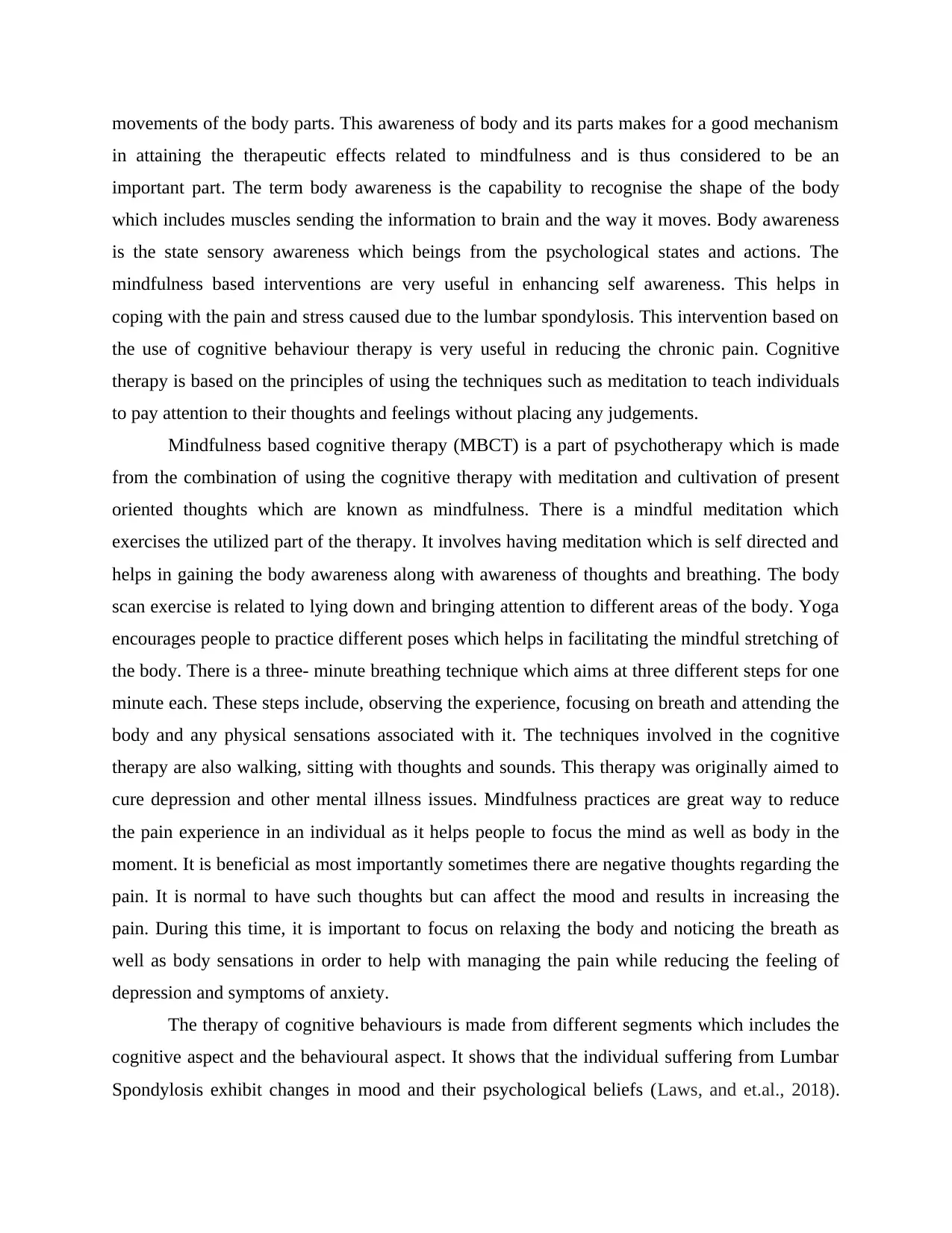
movements of the body parts. This awareness of body and its parts makes for a good mechanism
in attaining the therapeutic effects related to mindfulness and is thus considered to be an
important part. The term body awareness is the capability to recognise the shape of the body
which includes muscles sending the information to brain and the way it moves. Body awareness
is the state sensory awareness which beings from the psychological states and actions. The
mindfulness based interventions are very useful in enhancing self awareness. This helps in
coping with the pain and stress caused due to the lumbar spondylosis. This intervention based on
the use of cognitive behaviour therapy is very useful in reducing the chronic pain. Cognitive
therapy is based on the principles of using the techniques such as meditation to teach individuals
to pay attention to their thoughts and feelings without placing any judgements.
Mindfulness based cognitive therapy (MBCT) is a part of psychotherapy which is made
from the combination of using the cognitive therapy with meditation and cultivation of present
oriented thoughts which are known as mindfulness. There is a mindful meditation which
exercises the utilized part of the therapy. It involves having meditation which is self directed and
helps in gaining the body awareness along with awareness of thoughts and breathing. The body
scan exercise is related to lying down and bringing attention to different areas of the body. Yoga
encourages people to practice different poses which helps in facilitating the mindful stretching of
the body. There is a three- minute breathing technique which aims at three different steps for one
minute each. These steps include, observing the experience, focusing on breath and attending the
body and any physical sensations associated with it. The techniques involved in the cognitive
therapy are also walking, sitting with thoughts and sounds. This therapy was originally aimed to
cure depression and other mental illness issues. Mindfulness practices are great way to reduce
the pain experience in an individual as it helps people to focus the mind as well as body in the
moment. It is beneficial as most importantly sometimes there are negative thoughts regarding the
pain. It is normal to have such thoughts but can affect the mood and results in increasing the
pain. During this time, it is important to focus on relaxing the body and noticing the breath as
well as body sensations in order to help with managing the pain while reducing the feeling of
depression and symptoms of anxiety.
The therapy of cognitive behaviours is made from different segments which includes the
cognitive aspect and the behavioural aspect. It shows that the individual suffering from Lumbar
Spondylosis exhibit changes in mood and their psychological beliefs (Laws, and et.al., 2018).
in attaining the therapeutic effects related to mindfulness and is thus considered to be an
important part. The term body awareness is the capability to recognise the shape of the body
which includes muscles sending the information to brain and the way it moves. Body awareness
is the state sensory awareness which beings from the psychological states and actions. The
mindfulness based interventions are very useful in enhancing self awareness. This helps in
coping with the pain and stress caused due to the lumbar spondylosis. This intervention based on
the use of cognitive behaviour therapy is very useful in reducing the chronic pain. Cognitive
therapy is based on the principles of using the techniques such as meditation to teach individuals
to pay attention to their thoughts and feelings without placing any judgements.
Mindfulness based cognitive therapy (MBCT) is a part of psychotherapy which is made
from the combination of using the cognitive therapy with meditation and cultivation of present
oriented thoughts which are known as mindfulness. There is a mindful meditation which
exercises the utilized part of the therapy. It involves having meditation which is self directed and
helps in gaining the body awareness along with awareness of thoughts and breathing. The body
scan exercise is related to lying down and bringing attention to different areas of the body. Yoga
encourages people to practice different poses which helps in facilitating the mindful stretching of
the body. There is a three- minute breathing technique which aims at three different steps for one
minute each. These steps include, observing the experience, focusing on breath and attending the
body and any physical sensations associated with it. The techniques involved in the cognitive
therapy are also walking, sitting with thoughts and sounds. This therapy was originally aimed to
cure depression and other mental illness issues. Mindfulness practices are great way to reduce
the pain experience in an individual as it helps people to focus the mind as well as body in the
moment. It is beneficial as most importantly sometimes there are negative thoughts regarding the
pain. It is normal to have such thoughts but can affect the mood and results in increasing the
pain. During this time, it is important to focus on relaxing the body and noticing the breath as
well as body sensations in order to help with managing the pain while reducing the feeling of
depression and symptoms of anxiety.
The therapy of cognitive behaviours is made from different segments which includes the
cognitive aspect and the behavioural aspect. It shows that the individual suffering from Lumbar
Spondylosis exhibit changes in mood and their psychological beliefs (Laws, and et.al., 2018).
Paraphrase This Document
Need a fresh take? Get an instant paraphrase of this document with our AI Paraphraser
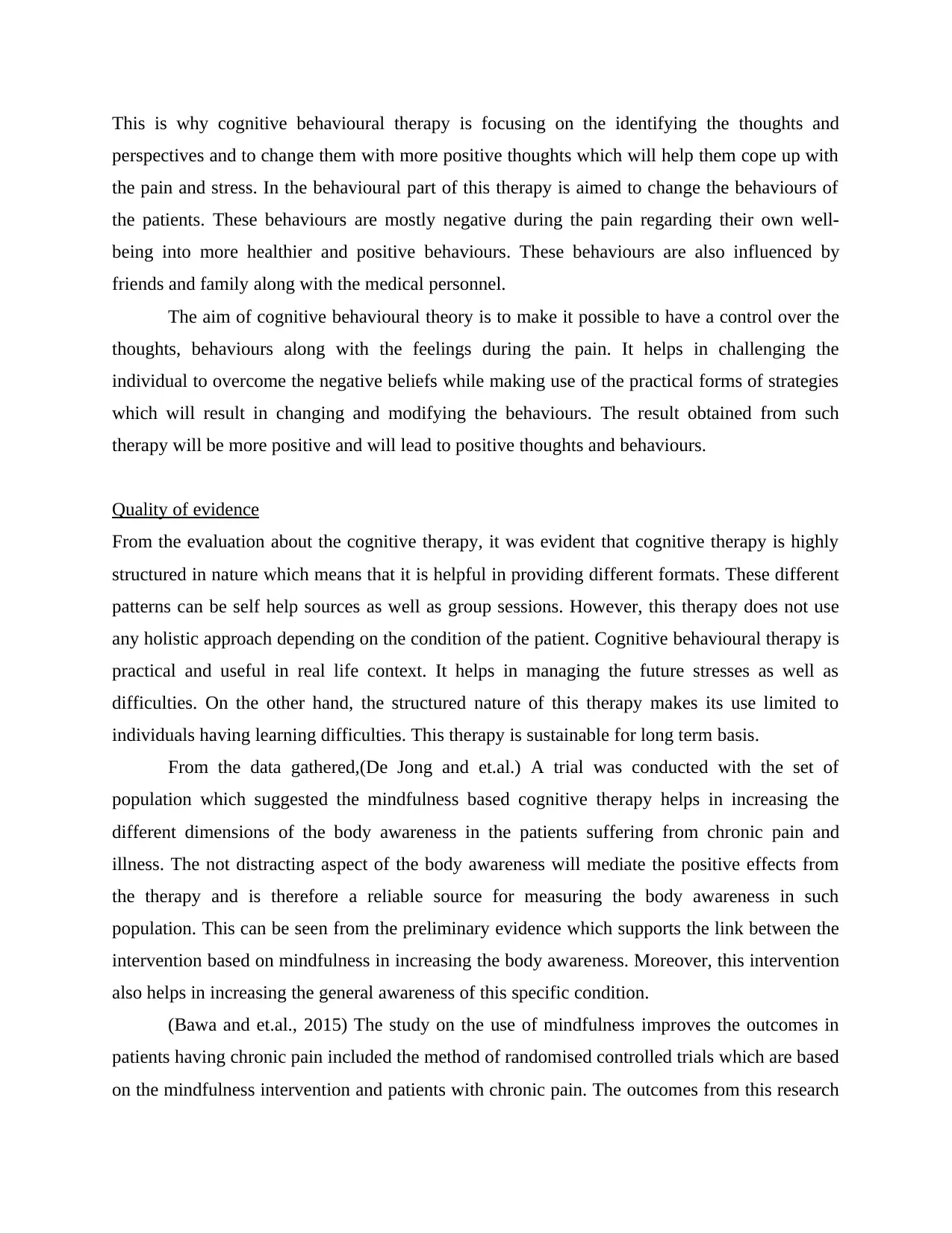
This is why cognitive behavioural therapy is focusing on the identifying the thoughts and
perspectives and to change them with more positive thoughts which will help them cope up with
the pain and stress. In the behavioural part of this therapy is aimed to change the behaviours of
the patients. These behaviours are mostly negative during the pain regarding their own well-
being into more healthier and positive behaviours. These behaviours are also influenced by
friends and family along with the medical personnel.
The aim of cognitive behavioural theory is to make it possible to have a control over the
thoughts, behaviours along with the feelings during the pain. It helps in challenging the
individual to overcome the negative beliefs while making use of the practical forms of strategies
which will result in changing and modifying the behaviours. The result obtained from such
therapy will be more positive and will lead to positive thoughts and behaviours.
Quality of evidence
From the evaluation about the cognitive therapy, it was evident that cognitive therapy is highly
structured in nature which means that it is helpful in providing different formats. These different
patterns can be self help sources as well as group sessions. However, this therapy does not use
any holistic approach depending on the condition of the patient. Cognitive behavioural therapy is
practical and useful in real life context. It helps in managing the future stresses as well as
difficulties. On the other hand, the structured nature of this therapy makes its use limited to
individuals having learning difficulties. This therapy is sustainable for long term basis.
From the data gathered,(De Jong and et.al.) A trial was conducted with the set of
population which suggested the mindfulness based cognitive therapy helps in increasing the
different dimensions of the body awareness in the patients suffering from chronic pain and
illness. The not distracting aspect of the body awareness will mediate the positive effects from
the therapy and is therefore a reliable source for measuring the body awareness in such
population. This can be seen from the preliminary evidence which supports the link between the
intervention based on mindfulness in increasing the body awareness. Moreover, this intervention
also helps in increasing the general awareness of this specific condition.
(Bawa and et.al., 2015) The study on the use of mindfulness improves the outcomes in
patients having chronic pain included the method of randomised controlled trials which are based
on the mindfulness intervention and patients with chronic pain. The outcomes from this research
perspectives and to change them with more positive thoughts which will help them cope up with
the pain and stress. In the behavioural part of this therapy is aimed to change the behaviours of
the patients. These behaviours are mostly negative during the pain regarding their own well-
being into more healthier and positive behaviours. These behaviours are also influenced by
friends and family along with the medical personnel.
The aim of cognitive behavioural theory is to make it possible to have a control over the
thoughts, behaviours along with the feelings during the pain. It helps in challenging the
individual to overcome the negative beliefs while making use of the practical forms of strategies
which will result in changing and modifying the behaviours. The result obtained from such
therapy will be more positive and will lead to positive thoughts and behaviours.
Quality of evidence
From the evaluation about the cognitive therapy, it was evident that cognitive therapy is highly
structured in nature which means that it is helpful in providing different formats. These different
patterns can be self help sources as well as group sessions. However, this therapy does not use
any holistic approach depending on the condition of the patient. Cognitive behavioural therapy is
practical and useful in real life context. It helps in managing the future stresses as well as
difficulties. On the other hand, the structured nature of this therapy makes its use limited to
individuals having learning difficulties. This therapy is sustainable for long term basis.
From the data gathered,(De Jong and et.al.) A trial was conducted with the set of
population which suggested the mindfulness based cognitive therapy helps in increasing the
different dimensions of the body awareness in the patients suffering from chronic pain and
illness. The not distracting aspect of the body awareness will mediate the positive effects from
the therapy and is therefore a reliable source for measuring the body awareness in such
population. This can be seen from the preliminary evidence which supports the link between the
intervention based on mindfulness in increasing the body awareness. Moreover, this intervention
also helps in increasing the general awareness of this specific condition.
(Bawa and et.al., 2015) The study on the use of mindfulness improves the outcomes in
patients having chronic pain included the method of randomised controlled trials which are based
on the mindfulness intervention and patients with chronic pain. The outcomes from this research
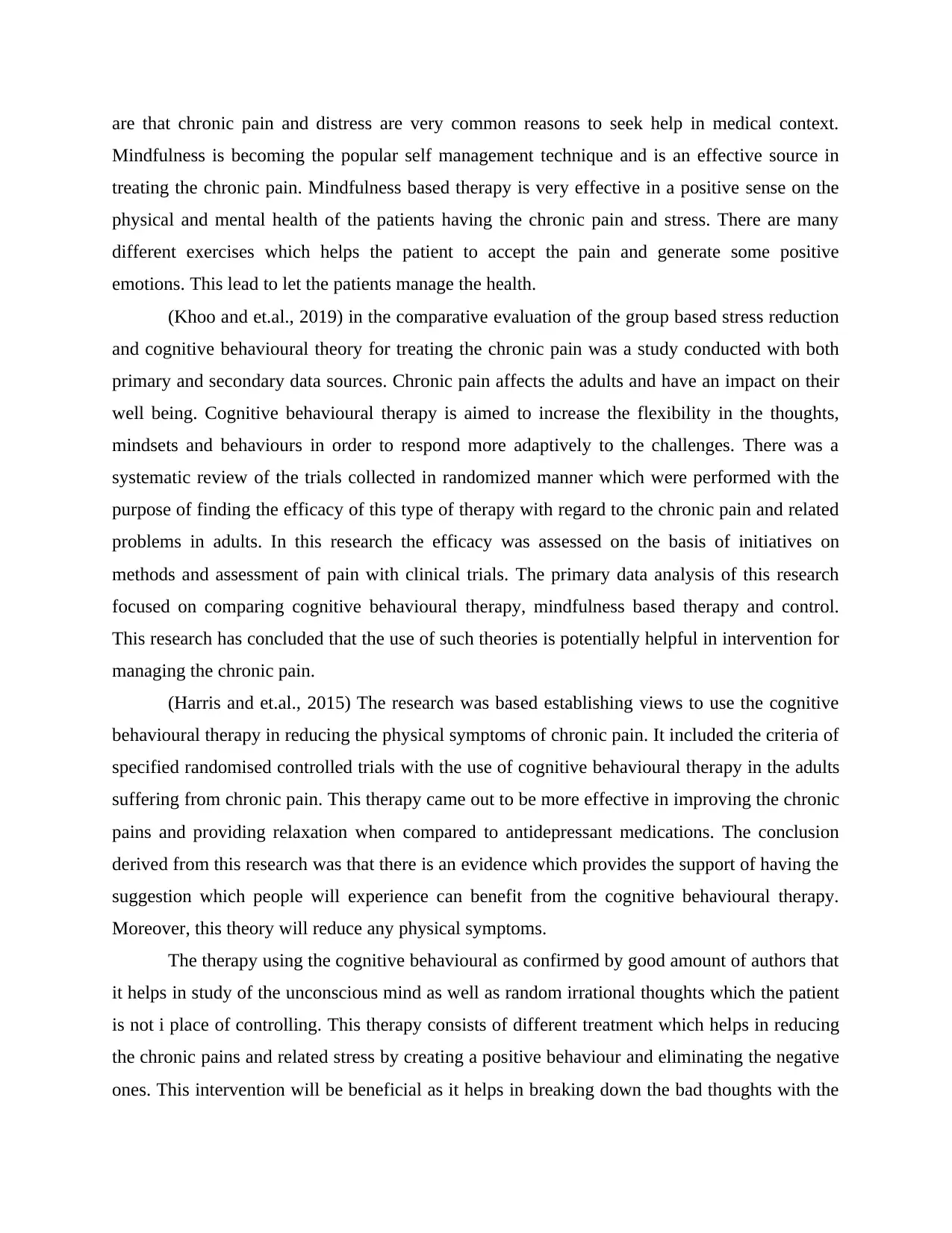
are that chronic pain and distress are very common reasons to seek help in medical context.
Mindfulness is becoming the popular self management technique and is an effective source in
treating the chronic pain. Mindfulness based therapy is very effective in a positive sense on the
physical and mental health of the patients having the chronic pain and stress. There are many
different exercises which helps the patient to accept the pain and generate some positive
emotions. This lead to let the patients manage the health.
(Khoo and et.al., 2019) in the comparative evaluation of the group based stress reduction
and cognitive behavioural theory for treating the chronic pain was a study conducted with both
primary and secondary data sources. Chronic pain affects the adults and have an impact on their
well being. Cognitive behavioural therapy is aimed to increase the flexibility in the thoughts,
mindsets and behaviours in order to respond more adaptively to the challenges. There was a
systematic review of the trials collected in randomized manner which were performed with the
purpose of finding the efficacy of this type of therapy with regard to the chronic pain and related
problems in adults. In this research the efficacy was assessed on the basis of initiatives on
methods and assessment of pain with clinical trials. The primary data analysis of this research
focused on comparing cognitive behavioural therapy, mindfulness based therapy and control.
This research has concluded that the use of such theories is potentially helpful in intervention for
managing the chronic pain.
(Harris and et.al., 2015) The research was based establishing views to use the cognitive
behavioural therapy in reducing the physical symptoms of chronic pain. It included the criteria of
specified randomised controlled trials with the use of cognitive behavioural therapy in the adults
suffering from chronic pain. This therapy came out to be more effective in improving the chronic
pains and providing relaxation when compared to antidepressant medications. The conclusion
derived from this research was that there is an evidence which provides the support of having the
suggestion which people will experience can benefit from the cognitive behavioural therapy.
Moreover, this theory will reduce any physical symptoms.
The therapy using the cognitive behavioural as confirmed by good amount of authors that
it helps in study of the unconscious mind as well as random irrational thoughts which the patient
is not i place of controlling. This therapy consists of different treatment which helps in reducing
the chronic pains and related stress by creating a positive behaviour and eliminating the negative
ones. This intervention will be beneficial as it helps in breaking down the bad thoughts with the
Mindfulness is becoming the popular self management technique and is an effective source in
treating the chronic pain. Mindfulness based therapy is very effective in a positive sense on the
physical and mental health of the patients having the chronic pain and stress. There are many
different exercises which helps the patient to accept the pain and generate some positive
emotions. This lead to let the patients manage the health.
(Khoo and et.al., 2019) in the comparative evaluation of the group based stress reduction
and cognitive behavioural theory for treating the chronic pain was a study conducted with both
primary and secondary data sources. Chronic pain affects the adults and have an impact on their
well being. Cognitive behavioural therapy is aimed to increase the flexibility in the thoughts,
mindsets and behaviours in order to respond more adaptively to the challenges. There was a
systematic review of the trials collected in randomized manner which were performed with the
purpose of finding the efficacy of this type of therapy with regard to the chronic pain and related
problems in adults. In this research the efficacy was assessed on the basis of initiatives on
methods and assessment of pain with clinical trials. The primary data analysis of this research
focused on comparing cognitive behavioural therapy, mindfulness based therapy and control.
This research has concluded that the use of such theories is potentially helpful in intervention for
managing the chronic pain.
(Harris and et.al., 2015) The research was based establishing views to use the cognitive
behavioural therapy in reducing the physical symptoms of chronic pain. It included the criteria of
specified randomised controlled trials with the use of cognitive behavioural therapy in the adults
suffering from chronic pain. This therapy came out to be more effective in improving the chronic
pains and providing relaxation when compared to antidepressant medications. The conclusion
derived from this research was that there is an evidence which provides the support of having the
suggestion which people will experience can benefit from the cognitive behavioural therapy.
Moreover, this theory will reduce any physical symptoms.
The therapy using the cognitive behavioural as confirmed by good amount of authors that
it helps in study of the unconscious mind as well as random irrational thoughts which the patient
is not i place of controlling. This therapy consists of different treatment which helps in reducing
the chronic pains and related stress by creating a positive behaviour and eliminating the negative
ones. This intervention will be beneficial as it helps in breaking down the bad thoughts with the
⊘ This is a preview!⊘
Do you want full access?
Subscribe today to unlock all pages.

Trusted by 1+ million students worldwide
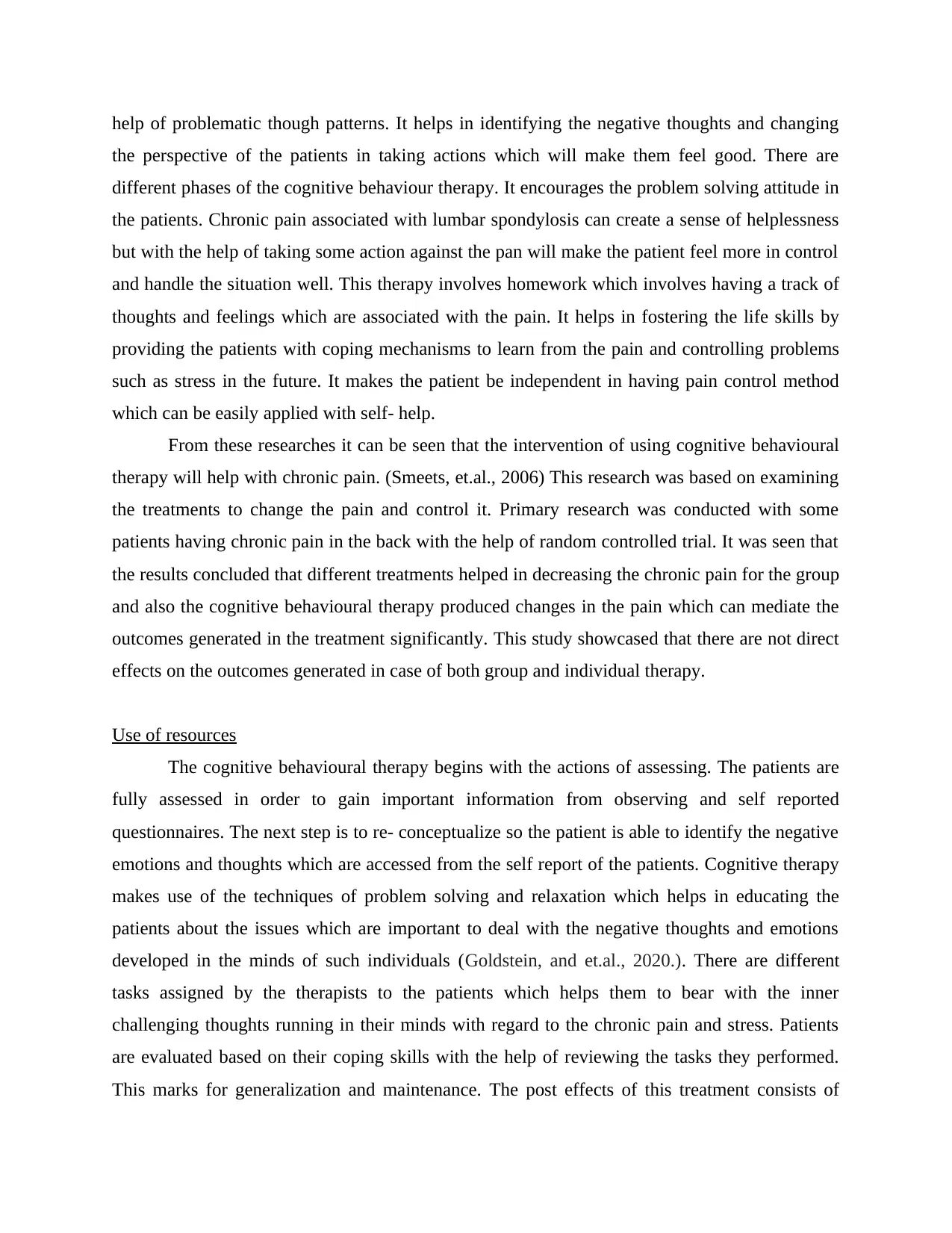
help of problematic though patterns. It helps in identifying the negative thoughts and changing
the perspective of the patients in taking actions which will make them feel good. There are
different phases of the cognitive behaviour therapy. It encourages the problem solving attitude in
the patients. Chronic pain associated with lumbar spondylosis can create a sense of helplessness
but with the help of taking some action against the pan will make the patient feel more in control
and handle the situation well. This therapy involves homework which involves having a track of
thoughts and feelings which are associated with the pain. It helps in fostering the life skills by
providing the patients with coping mechanisms to learn from the pain and controlling problems
such as stress in the future. It makes the patient be independent in having pain control method
which can be easily applied with self- help.
From these researches it can be seen that the intervention of using cognitive behavioural
therapy will help with chronic pain. (Smeets, et.al., 2006) This research was based on examining
the treatments to change the pain and control it. Primary research was conducted with some
patients having chronic pain in the back with the help of random controlled trial. It was seen that
the results concluded that different treatments helped in decreasing the chronic pain for the group
and also the cognitive behavioural therapy produced changes in the pain which can mediate the
outcomes generated in the treatment significantly. This study showcased that there are not direct
effects on the outcomes generated in case of both group and individual therapy.
Use of resources
The cognitive behavioural therapy begins with the actions of assessing. The patients are
fully assessed in order to gain important information from observing and self reported
questionnaires. The next step is to re- conceptualize so the patient is able to identify the negative
emotions and thoughts which are accessed from the self report of the patients. Cognitive therapy
makes use of the techniques of problem solving and relaxation which helps in educating the
patients about the issues which are important to deal with the negative thoughts and emotions
developed in the minds of such individuals (Goldstein, and et.al., 2020.). There are different
tasks assigned by the therapists to the patients which helps them to bear with the inner
challenging thoughts running in their minds with regard to the chronic pain and stress. Patients
are evaluated based on their coping skills with the help of reviewing the tasks they performed.
This marks for generalization and maintenance. The post effects of this treatment consists of
the perspective of the patients in taking actions which will make them feel good. There are
different phases of the cognitive behaviour therapy. It encourages the problem solving attitude in
the patients. Chronic pain associated with lumbar spondylosis can create a sense of helplessness
but with the help of taking some action against the pan will make the patient feel more in control
and handle the situation well. This therapy involves homework which involves having a track of
thoughts and feelings which are associated with the pain. It helps in fostering the life skills by
providing the patients with coping mechanisms to learn from the pain and controlling problems
such as stress in the future. It makes the patient be independent in having pain control method
which can be easily applied with self- help.
From these researches it can be seen that the intervention of using cognitive behavioural
therapy will help with chronic pain. (Smeets, et.al., 2006) This research was based on examining
the treatments to change the pain and control it. Primary research was conducted with some
patients having chronic pain in the back with the help of random controlled trial. It was seen that
the results concluded that different treatments helped in decreasing the chronic pain for the group
and also the cognitive behavioural therapy produced changes in the pain which can mediate the
outcomes generated in the treatment significantly. This study showcased that there are not direct
effects on the outcomes generated in case of both group and individual therapy.
Use of resources
The cognitive behavioural therapy begins with the actions of assessing. The patients are
fully assessed in order to gain important information from observing and self reported
questionnaires. The next step is to re- conceptualize so the patient is able to identify the negative
emotions and thoughts which are accessed from the self report of the patients. Cognitive therapy
makes use of the techniques of problem solving and relaxation which helps in educating the
patients about the issues which are important to deal with the negative thoughts and emotions
developed in the minds of such individuals (Goldstein, and et.al., 2020.). There are different
tasks assigned by the therapists to the patients which helps them to bear with the inner
challenging thoughts running in their minds with regard to the chronic pain and stress. Patients
are evaluated based on their coping skills with the help of reviewing the tasks they performed.
This marks for generalization and maintenance. The post effects of this treatment consists of
Paraphrase This Document
Need a fresh take? Get an instant paraphrase of this document with our AI Paraphraser
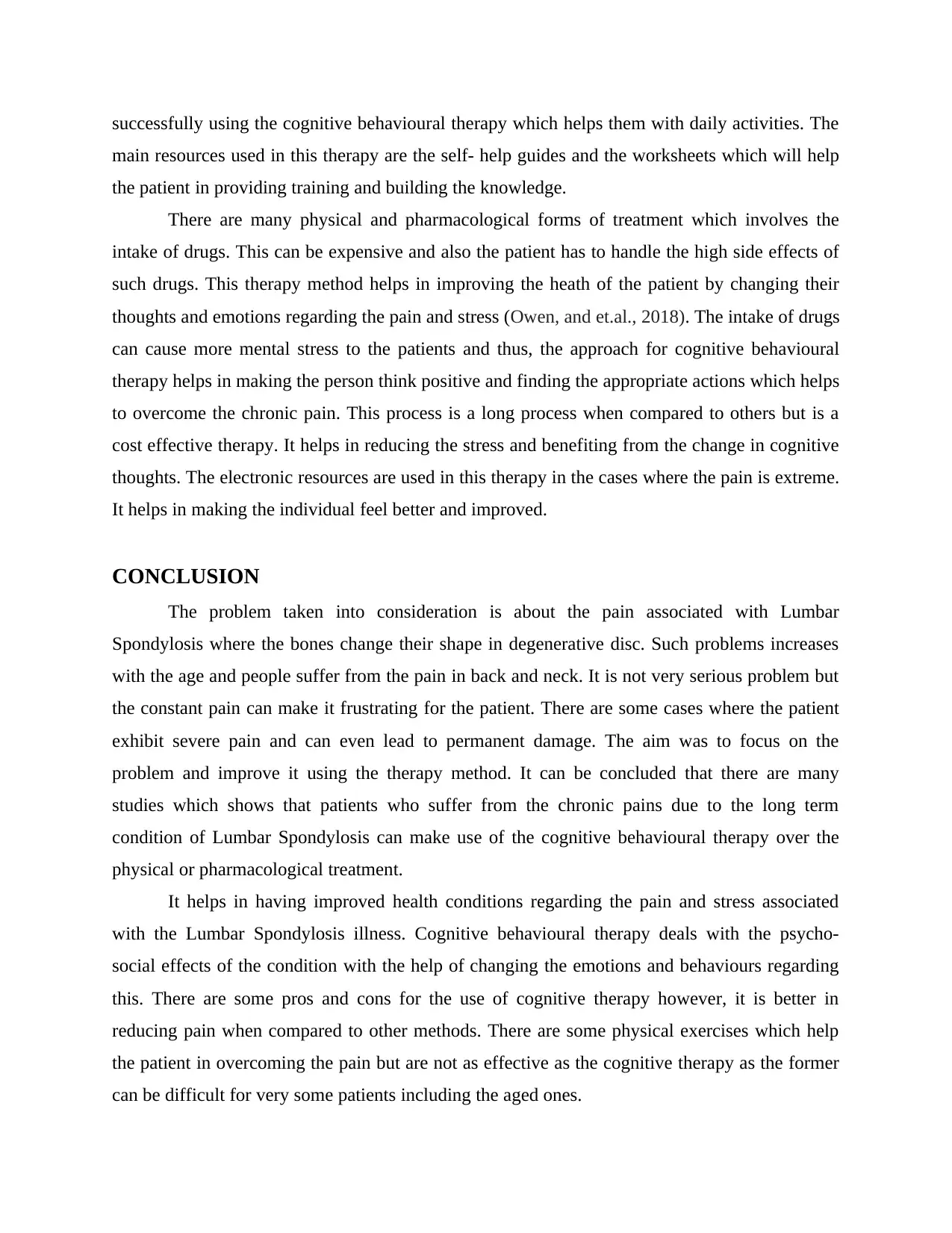
successfully using the cognitive behavioural therapy which helps them with daily activities. The
main resources used in this therapy are the self- help guides and the worksheets which will help
the patient in providing training and building the knowledge.
There are many physical and pharmacological forms of treatment which involves the
intake of drugs. This can be expensive and also the patient has to handle the high side effects of
such drugs. This therapy method helps in improving the heath of the patient by changing their
thoughts and emotions regarding the pain and stress (Owen, and et.al., 2018). The intake of drugs
can cause more mental stress to the patients and thus, the approach for cognitive behavioural
therapy helps in making the person think positive and finding the appropriate actions which helps
to overcome the chronic pain. This process is a long process when compared to others but is a
cost effective therapy. It helps in reducing the stress and benefiting from the change in cognitive
thoughts. The electronic resources are used in this therapy in the cases where the pain is extreme.
It helps in making the individual feel better and improved.
CONCLUSION
The problem taken into consideration is about the pain associated with Lumbar
Spondylosis where the bones change their shape in degenerative disc. Such problems increases
with the age and people suffer from the pain in back and neck. It is not very serious problem but
the constant pain can make it frustrating for the patient. There are some cases where the patient
exhibit severe pain and can even lead to permanent damage. The aim was to focus on the
problem and improve it using the therapy method. It can be concluded that there are many
studies which shows that patients who suffer from the chronic pains due to the long term
condition of Lumbar Spondylosis can make use of the cognitive behavioural therapy over the
physical or pharmacological treatment.
It helps in having improved health conditions regarding the pain and stress associated
with the Lumbar Spondylosis illness. Cognitive behavioural therapy deals with the psycho-
social effects of the condition with the help of changing the emotions and behaviours regarding
this. There are some pros and cons for the use of cognitive therapy however, it is better in
reducing pain when compared to other methods. There are some physical exercises which help
the patient in overcoming the pain but are not as effective as the cognitive therapy as the former
can be difficult for very some patients including the aged ones.
main resources used in this therapy are the self- help guides and the worksheets which will help
the patient in providing training and building the knowledge.
There are many physical and pharmacological forms of treatment which involves the
intake of drugs. This can be expensive and also the patient has to handle the high side effects of
such drugs. This therapy method helps in improving the heath of the patient by changing their
thoughts and emotions regarding the pain and stress (Owen, and et.al., 2018). The intake of drugs
can cause more mental stress to the patients and thus, the approach for cognitive behavioural
therapy helps in making the person think positive and finding the appropriate actions which helps
to overcome the chronic pain. This process is a long process when compared to others but is a
cost effective therapy. It helps in reducing the stress and benefiting from the change in cognitive
thoughts. The electronic resources are used in this therapy in the cases where the pain is extreme.
It helps in making the individual feel better and improved.
CONCLUSION
The problem taken into consideration is about the pain associated with Lumbar
Spondylosis where the bones change their shape in degenerative disc. Such problems increases
with the age and people suffer from the pain in back and neck. It is not very serious problem but
the constant pain can make it frustrating for the patient. There are some cases where the patient
exhibit severe pain and can even lead to permanent damage. The aim was to focus on the
problem and improve it using the therapy method. It can be concluded that there are many
studies which shows that patients who suffer from the chronic pains due to the long term
condition of Lumbar Spondylosis can make use of the cognitive behavioural therapy over the
physical or pharmacological treatment.
It helps in having improved health conditions regarding the pain and stress associated
with the Lumbar Spondylosis illness. Cognitive behavioural therapy deals with the psycho-
social effects of the condition with the help of changing the emotions and behaviours regarding
this. There are some pros and cons for the use of cognitive therapy however, it is better in
reducing pain when compared to other methods. There are some physical exercises which help
the patient in overcoming the pain but are not as effective as the cognitive therapy as the former
can be difficult for very some patients including the aged ones.

⊘ This is a preview!⊘
Do you want full access?
Subscribe today to unlock all pages.

Trusted by 1+ million students worldwide
1 out of 14
Related Documents
Your All-in-One AI-Powered Toolkit for Academic Success.
+13062052269
info@desklib.com
Available 24*7 on WhatsApp / Email
![[object Object]](/_next/static/media/star-bottom.7253800d.svg)
Unlock your academic potential
Copyright © 2020–2025 A2Z Services. All Rights Reserved. Developed and managed by ZUCOL.





